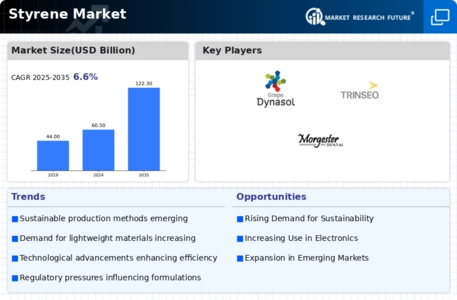Leading market players are investing heavily in research and development in order to expand their product lines, which will help the Styrene market grow even more. Market participants are also undertaking a variety of strategic activities to expand their footprint, with important market developments including new product launches, contractual agreements, mergers and acquisitions, higher investments, and collaboration with other organizations. To expand and survive in a more competitive and rising market climate, the Styrene industry must offer cost-effective items.
Manufacturing locally to minimize operational costs is one of the key business tactics used by manufacturers in the Styrene industry to benefit clients and increase the market sector. In recent years, the Styrene industry has offered some of the most significant advantages to different industries. Major players in the Styrene market, including Chevron Phillips Chemical Company LLC., Alpek SAB DE CV, Ineos Group AG, Nova Chemicals Corporation, Shell plc, LG Chem Ltd, Dynasol Group, Kraton Corporation, Trinseo, Elevate, and others, are attempting to increase market demand by investing in research and development operations.
INEOS is one of the world's largest chemical companies, involved in the production of a wide range of petrochemicals, specialty chemicals, and polymers. They serve a broad array of industries, including automotive, construction, healthcare, packaging, and more. The company's product portfolio includes chemicals such as ethylene, propylene, and various derivatives, as well as polymers like polyethylene and polypropylene. They also produce a range of specialty chemicals and products. INEOS emphasizes innovation and research, working to develop advanced materials and technologies that cater to the evolving needs of industries while also focusing on sustainability and environmental responsibility.
The company is actively involved in corporate social responsibility initiatives, with a commitment to safety, ethical business practices, and community engagement. In August 2023, INEOS and TotalEnergies announced a partnership to develop and commercialize new polystyrene recycling technologies. This partnership aims to increase the circularity of the polystyrene industry and reduce its environmental impact.
Huntsman Corporation is a chemical company headquartered in The Woodlands, Texas, with a significant presence in the chemical industry. With a legacy dating back to 1970, Huntsman has grown to become a leading provider of a wide range of chemical products and solutions. The company operates in multiple business segments, including Polyurethanes, Performance Products, Advanced Materials, and Textile Effects, serving industries such as automotive, construction, packaging, textiles, and electronics. Huntsman is known for its commitment to innovation and sustainability, consistently developing advanced materials and technologies while prioritizing responsible and eco-friendly practices.
They are actively involved in various corporate social responsibility initiatives, including those related to safety, ethics, and community engagement. In July 2023, Huntsman Chemical and Mitsui Chemicals announced a partnership to develop and produce new sustainable styrene monomer technologies. This partnership aims to reduce the greenhouse gas emissions associated with styrene monomer production.













